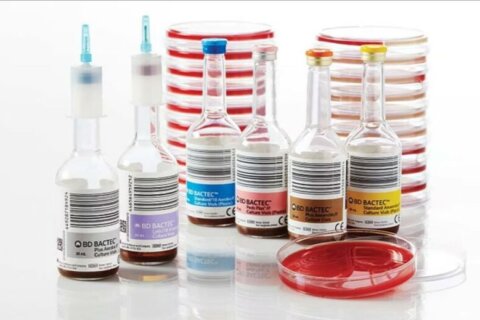After a train accident severed his leg while he was working in India in 2011, David Ricci was airlifted home to a hospital in Seattle, where doctors discovered that he was infected with several strains of resistant bacteria. The 19-year-old was immediately moved into isolation and given antibiotic after antibiotic with no success. He underwent several surgeries to remove infected tissue. Finally, several months after the ordeal began, his infection began to clear. But Ricci, who is now in college and hopes to go to medical school, isn’t out of danger entirely. “The doctors told me that it might be hiding out in my body’s cells, and I had a 30 percent chance of the infection recurring,” he says. “Every year that it doesn’t come back, the percentage drops a little.”
Ricci is one of a growing number of Americans battling potentially lethal “superbugs” that are proving harder and harder to control with antibiotics. Drug-resistant bacteria affect more than 2 million people in the U.S. every year and kill at least 23,000, according to the Centers for Disease Control and Prevention, many of them in hospitals. The National Institutes of Health’s own clinical center in Maryland saw 18 patients become infected in 2011 with Klebsiella pneumoniae carbapenemase or KPC, which can cause pneumonia, meningitis and infections in the bloodstream or at surgical sites. Seven died. An outbreak of carbapenem-resistant Enterobacteriaceae, dubbed the “nightmare bacteria,” killed at least two patients at UCLA’s Ronald Reagan Medical Center last fall and winter.
But such bugs are becoming more prevalent everywhere, largely due to the misuse of antibiotics. A resistant strain of the highly contagious Shigella bacteria, initially spread by people who had contracted it while traveling outside the U.S., has sickened at least 243 Americans over the last year. And health officials are concerned about growing rates of multidrug resistant forms of tuberculosis, gonorrhea and methicillin-resistant Staphylococcus aureus, or MRSA, a potentially deadly strain of staph.
“It took more than a month and several different antibiotics to get rid of it,” says Carl Mullan, 50, who encountered MRSA when he cut his thumb on a blue crab shell while on the Virginia coast last year. The Portland, Oregon-based writer developed a skin infection that quickly spread to his nose and chest. Mullan has been advised that his body may still harbor the bacteria, which could lead to a recurrence.
Many hospitals have made impressive strides in preventing health care-associated infections; some have seen a 70 percent reduction in the rate of bloodstream infections, thanks to safeguards such as checklists of steps to take before and during medical procedures and stepped-up hand-washing. But the problem continues to worsen. Now the White House has asked Congress for $1.2 billion to fund an effort to cut the rate of dangerous infections in half by 2020. The plan includes steps to prevent and slow the spread of infection, improve surveillance of resistant bugs, develop better diagnostic tests and new antibiotics and curb the misuse of currently available drugs — the main driver of drug resistance.
This is no fleeting crisis. Experts warn that the loss of antibiotics would roll back medical progress by 70 or 80 years. Without them, people could die of everyday dental abscesses and strep throat. Just inserting an IV could have lethal consequences. “Medical practice developed in a way that presumes the ability to treat infection in order to allow other things to be done like major surgery, cancer chemotherapy, transplants and joint replacement,” says James Johnson, senior associate director of the Infectious Disease Fellowship Program at the University of Minnesota in Minneapolis.
In terms of their power and importance, “almost nothing else in medicine comes close,” says Brad Spellberg, chief medical officer and professor of clinical medicine at the Los Angeles County and USC Medical Center. He is also the author of “Rising Plague: The Global Threat from Deadly Bacteria and Our Dwindling Arsenal to Fight Them.”
The trouble is that “any time we use antibiotics, we’re contributing to their future ineffectiveness,” Johnson says. It’s natural for an organism to eventually become resistant to that drug. And too often, bowing to the demands of patients, doctors prescribe antibiotics when they’re not needed; the drugs aren’t effective against viral illnesses.
Another problem: Because it takes time to determine precisely which organism is the culprit, doctors frequently prescribe “broad spectrum” antibiotics that work against a wide range of bacteria when a more targeted drug would do. “The consequence,” Johnson says, is that “we’re using our last-reserve antibiotics with increasing frequency.” The CDC estimates that at least 50 percent of antibiotic use in humans is unnecessary or inappropriate.
At the same time, 80 percent of antibiotics in the U.S. are used in livestock feed to prevent or control infection and promote growth, which fuels outbreaks of drug-resistant organisms such as Salmonella, E. coli and Campylobacter that spread through the environment. The end result: “There are patients in hospitals in the U.S. today suffering and dying from infections for which doctors have no antibiotics to give,” says Arjun Srinivasan, associate director for Healthcare Associated Infection Prevention Programs for the CDC. “They are completely resistant to all therapies.” Experts agree that no single intervention will solve the problem — and are exploring a number of needed solutions:
Protecting a Precious Resource
Under the president’s plan, hospitals would establish antibiotic stewardship programs to focus doctors on “prescribing the right antibiotic at the right time at the right dose for the right duration,” says Ann McIntyre, clinical associate professor in internal medicine at Nova Southeastern University and director of the infectious diseases fellowship program at Palmetto General Hospital in Florida. Only about half of hospitals currently have such programs. But the Centers for Medicare and Medicaid Services is expected to make them a requirement for eligibility for reimbursements by 2017. Typically led by a multidisciplinary team — infectious disease doctors, pharmacists, microbiologists or epidemiologists and nurses — stewardship programs involve keeping careful control over how the drugs are dispensed. They include such strategies as frequently reviewing patients’ status to make sure they still need an antibiotic, and if so, reassessing the drug, dosage and type of delivery (switching from IV to oral antibiotics, for instance, eliminates a potential source of additional infection), and restricting the use of certain broad spectrum antibiotics until an antibiotic expert weighs in. “Physicians are used to practicing for the patient in the moment and not having to think about all patients globally,” says Neil Fishman, an infectious disease specialist and chief patient safety officer at the University of Pennsylvania Health System. That, he says, has to change.
Studies suggest that stewardship programs may have other benefits. After Kenmore Mercy Hospital in New York started a stewardship program several years ago, rates of dangerous Clostridium difficile infections — which often result when a course of antibiotics wipes out protective bacteria in the gut, allowing resistant bad bugs to proliferate — dropped along with unnecessary antibiotic use, suggesting a possible relationship. At the same time, says Kenmore Mercy’s lead pharmacist James Bartlett, “we saw a $145,000 decrease in antibiotic acquisition costs.”
In California, where the programs are already mandated, rural and community hospitals can turn to TeleMed2U, a telemedicine service that provides the expertise of an infectious disease specialist and basic stewardship functions 24/7 at a fraction of the cost of hiring an expert. In one hospital relying on the services, the use of the broad-spectrum antibiotics has dropped by 70 percent, says chief medical officer Javeed Siddiqui.
Speeding New Antibiotics to Market
Conserving the current arsenal is only part of the equation. New antibiotics are always going to be needed to outsmart resistant bacteria. Yet development has slowed by 80 percent over the last 20 years due to regulatory and market realities. “Drug companies can make more money developing medications that you take for the rest of your life, for things like high blood pressure and high cholesterol,” Spellberg says.
To lure companies back, a law was passed in 2012 — the Generating Antibiotic Incentives Now Act — giving them an extra five years to sell a new entrant exclusively before generics can be introduced, as well as fast-track Food and Drug Administration approval for new antibiotics. According to the Pew Charitable Trusts, 36 antibiotics are currently in the U.S. pipeline. Most are still in early clinical trials. There are eight drugs in final trials, of which four or five are likely to make it to market.
Farther out on the horizon, scientists are applying out-of-the-box thinking to create new antibiotics and to preserve the usefulness of those already on the shelf. For instance, Duke University researchers are exploring a promising strategy to potentially restore the usefulness of older antibiotics. Bacteria seem susceptible to doses of these drugs for a period before an enzyme they release disables the drugs. If dosing can be adjusted to match up with that window, an antibiotic could in theory wipe the bugs out before it becomes ineffective.
And just this year, an international team including Northeastern University researchers announced the discovery of a novel way to grow potentially useful microbes in soil rather than in the lab, where few thrive. The approach has already yielded Teixobactin, an antibiotic that has proven highly effective in mice studies against Clostridium difficile and other common infections. Human tests are now planned.
There is also a need for rapid diagnostic tests that could be used at the bedside or in physicians’ offices to immediately determine whether an infection is due to a virus or a bacteria — and of what type. “That would give doctors the confidence to either not prescribe an antibiotic or to prescribe a narrow spectrum ‘sniper’ pill rather than a broad spectrum ‘atom bomb,’?” says Johnson.
Challenging Agricultural Use
Regularly feeding livestock antibiotics creates a reservoir of drug-resistant bacteria that wind up in animal tissue, and growing evidence is showing links between contaminated meat and multidrug resistant infections in humans. In a recent study, researchers at George Washington University and the Translational Genomics Research Institute in Flagstaff, Arizona, used DNA sequencing and found a high level of overlap between the strains of E. coli in meat purchased from stores around Flagstaff and drug-resistant urinary tract infections showing up at area hospitals. How the bugs get in both places is under investigation, says Lance Price, director of the Antibiotic Resistance Action Center at GWU’s Milken School of Public Health. Particles of animal feces harboring bacteria may drift in the air, be swept into the water supply or be carried by insects or rodents.
The president’s plan calls for food producers to limit the use of medically important antibiotics and to eliminate use simply to make animals grow bigger and faster. Pledges from McDonald’s and other restaurants to phase out meat raised with antibiotics and public pressure could add incentive. “If enough people vote with their feet, the industry will respond,” Johnson says.
Enlisting Patients
Health consumers have a distinct role to play, too, says Lauri Hicks, a medical epidemiologist for the CDC’s National Center for Immunization and Respiratory Diseases. For starters, they should not pressure doctors for antibiotics when not needed. And if a drug is required, they can ask for the narrowest spectrum of antibiotic that will do the job. Getting all recommended vaccinations helps avoid infection in the first place.
Hospital patients should ask if tests will be done to make sure the right antibiotic is prescribed. If a catheter is in place, which increases the risk of infection, they should ask each day if it is still necessary. Patients who experience diarrhea three or more times in 24 hours while taking antibiotics should alert their doctor, since it could indicate Clostridium difficile.
Such precautions will be too late for the people already beyond the reach of current drugs. “Fortunately, these cases are rare,” Srinivasan says. But if we don’t take action now, he warns, that will no longer be true.
Excerpted from U.S. News’ “Best Hospitals 2016,” the definitive consumer guidebook to U.S. hospitals. Order your copy now.
More from U.S. News
Which Practitioner Do I See, and When?
7 Reasons to Call Off a Surgery
14 Things You Didn’t Know About Nurses
The New War on Superbugs originally appeared on usnews.com







